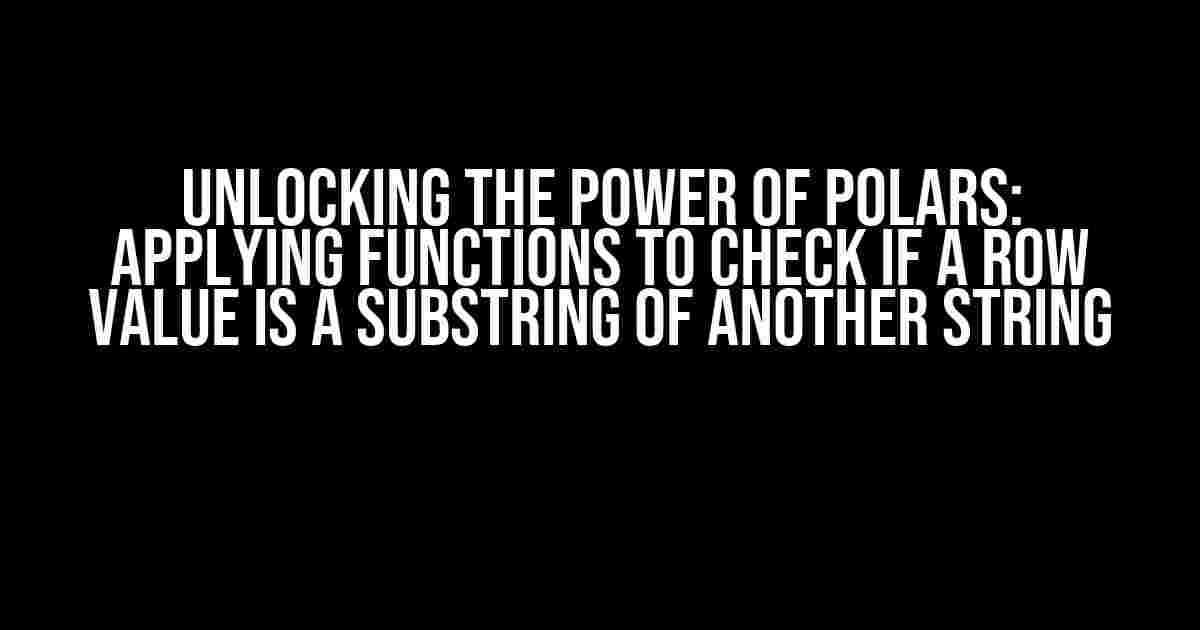Are you tired of wrestling with complex data manipulation tasks in Python? Look no further! In this article, we’ll delve into the fantastic world of Polars, a high-performance, in-memory data processing library that’s changing the game. Specifically, we’ll explore how to apply functions to check if a row value is a substring of another string using Polars. By the end of this comprehensive guide, you’ll be equipped with the skills to tackle even the most demanding data challenges.
What is Polars, and Why Should You Care?
Polars is a blazing-fast, columnar data processing library built on top of Rust and Python. It’s designed to handle massive datasets with ease, making it an ideal choice for data scientists, engineers, and analysts alike. With Polars, you can perform various data operations, including filtering, sorting, grouping, and more, at incredible speeds. In this article, we’ll focus on applying functions to check if a row value is a substring of another string, but the possibilities with Polars are endless!
Preparing Your Polars Environment
Before we dive into the meat of the article, make sure you have Polars installed in your Python environment. You can do this by running the following command:
pip install polarsOnce installed, you’re ready to start exploring the world of Polars!
Creating a Sample Dataset
To demonstrate the power of Polars, let’s create a sample dataset. We’ll create a simple DataFrame with two columns: `name` and `description`. The `name` column will contain a list of fictional company names, and the `description` column will contain a brief description of each company.
import polars as pl
data = {
"name": ["Acme Inc.", "Best Products Ltd.", "Global Solutions Corp."],
"description": ["Manufactures widgets and gadgets.", "Produces high-quality consumer goods.", "Offers innovative software solutions."]
}
df = pl.DataFrame(data)
print(df)This will output the following DataFrame:
| Name | Description |
|---|---|
| Acme Inc. | Manufactures widgets and gadgets. |
| Best Products Ltd. | Produces high-quality consumer goods. |
| Global Solutions Corp. | Offers innovative software solutions. |
Applying Functions to Check if a Row Value is a Substring of Another String
Now that we have our sample dataset, let’s say we want to check if the `name` column contains a specific substring, “Inc.”. We can achieve this using Polars’ `str.contains()` function. Here’s how:
result = df.select(pl.col("name").str.contains("Inc."))
print(result)This will output a new DataFrame with a single column, `name`, containing boolean values indicating whether the `name` column contains the substring “Inc.”:
| Name |
|---|
| true |
| false |
| false |
We can take this a step further by using Polars’ `when_then` function to create a new column that contains a specific value if the condition is met:
result = df.with_column(
pl.when(pl.col("name").str.contains("Inc.")).then("Is an Inc. company").otherwise("Not an Inc. company")
)
print(result)This will output a new DataFrame with an additional column, `inc_company`, containing the corresponding values:
| Name | Description | |
|---|---|---|
| Acme Inc. | Manufactures widgets and gadgets. | Is an Inc. company |
| Best Products Ltd. | Produces high-quality consumer goods. | Not an Inc. company |
| Global Solutions Corp. | Offers innovative software solutions. | Not an Inc. company |
Using Other String Functions
Polars provides a range of string functions that can be used to manipulate and analyze text data. Here are a few more examples:
str.startswith(): Checks if a string starts with a specified value.str.endswith(): Checks if a string ends with a specified value.str.contains(): Checks if a string contains a specified value (as we saw earlier).str.replace(): Replaces a specified value with another value in a string.str.lower(): Converts a string to lowercase.str.upper(): Converts a string to uppercase.str.strip(): Removes leading and trailing whitespace from a string.str.lstrip(): Removes leading whitespace from a string.str.rstrip(): Removes trailing whitespace from a string.
These string functions can be used in various combinations to achieve complex text manipulation and analysis tasks.
Conclusion
In this article, we’ve explored the power of Polars in applying functions to check if a row value is a substring of another string. We’ve seen how to create a sample dataset, use the `str.contains()` function to check for substrings, and apply conditional logic using the `when_then` function. We’ve also touched on the range of string functions available in Polars, which can be used to manipulate and analyze text data.
Polars is an incredibly versatile library that can handle a wide range of data processing tasks. With its speed, efficiency, and ease of use, it’s an ideal choice for anyone working with large datasets. Whether you’re a seasoned data scientist or just starting out, Polars is definitely worth exploring.
What’s Next?
Now that you’ve mastered applying functions to check if a row value is a substring of another string using Polars, you might want to explore more advanced topics, such as:
- Grouping and aggregation
- Data filtering and sorting
- Joining and merging datasets
- Data visualization with Polars
The possibilities with Polars are endless, and we hope this article has inspired you to dive deeper into the world of high-performance data processing!
Frequently Asked Question
Get ready to dive into the world of Polars and substring checks!
How do I apply a function to check if a row value is a substring of another string in Polars?
You can use the `str.contains` method in Polars to check if a row value is a substring of another string. For example, `df[‘column_name’].str.contains(‘substring_to_look_for’)` will return a boolean series indicating whether each row value contains the specified substring.
Can I use a conditional statement to filter rows based on the substring check?
Yes, you can use a conditional statement to filter rows based on the substring check. For example, `df.filter(df[‘column_name’].str.contains(‘substring_to_look_for’))` will return a new DataFrame with only the rows where the column value contains the specified substring.
How do I ignore case when checking for substrings in Polars?
You can use the `str.contains` method with the `case_sensitive` parameter set to `False` to ignore case when checking for substrings. For example, `df[‘column_name’].str.contains(‘substring_to_look_for’, case_sensitive=False)` will perform a case-insensitive substring check.
Can I use regex patterns with the substring check in Polars?
Yes, you can use regex patterns with the substring check in Polars. For example, `df[‘column_name’].str.contains(r’regex_pattern’, regex=True)` will perform a regex-based substring check.
How do I perform a substring check on multiple columns in Polars?
You can use the `select` method and chain multiple `str.contains` calls to perform a substring check on multiple columns. For example, `df.select((pl.col(‘column1’).str.contains(‘substring_to_look_for’), pl.col(‘column2’).str.contains(‘substring_to_look_for’)))`. This will return a new DataFrame with two columns, each indicating whether the corresponding column value contains the specified substring.




![ValueError: JSON String “{" is not Valid JSON [Closed]: Unraveling the Mystery ValueError: JSON String “{" is not Valid JSON [Closed]: Unraveling the Mystery](https://freedman.hkhazo.biz.id/wp-content/uploads/sites/865/2024/07/valueerror-json-string-is-not-valid-json-closed-unraveling-the-mystery-with-text-300x300.jpg)